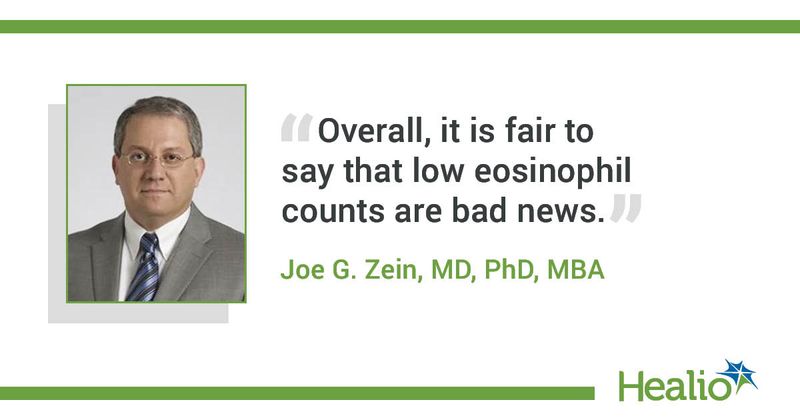Eosinophilia linked to better COVID-19 outcomes when patients use inhaled corticosteroids
Patients with high eosinophil counts experienced improved COVID-19 outcomes when they received inhaled corticosteroids, according to a study published in The Journal of Allergy and Clinical Immunology: In Practice.
“This study, funded by NIH-NHLBI, was done to assess the effect of eosinophils in COVID-19,” Joe G. Zein, MD, PhD, MBA, staff physician at Cleveland Clinic Respiratory Institute, told Healio.

Eosinophils have antiviral properties, particularly against respiratory viruses such as rhinovirus, parainfluenza and influenza, said Zein, who also is an associate professor of medicine at Cleveland Clinic Lerner College of Medicine.
“We wanted to see whether those antiviral properties translate to a better immune response to COVID-19 and an improved outcome,” Zein continued.
The study involved 46,397 patients in the Cleveland Clinic COVID-19 Research Registry database who tested positive for SARS-CoV-2 between April 1, 2020, and March 31, 2021, and who had a complete blood count prior to their COVID-19 diagnosis.
These patients included 6,739 who had been diagnosed with asthma and 3,066 with COPD/emphysema. Overall, 5,011 patients had been prescribed inhaled corticosteroids (iCS).
Of the patients, 9,096 (19.6%) were hospitalized, 2,129 (4.6%) required ICU admission and 1,402 (3%) died during hospitalization.
The database identified 19,506 patients with baseline eosinophilia (> 0.15 × 103 cells/µL; median age, 56.3 years; interquartile range [IQR], 42.1-69.3; 54.4% women). The remaining 26,891 patients had low eosinophil levels (< 0.15 × 103 cells/µL; median age, 50.6 years; IQR, 35.8-64.4; 61.8% women).
In unadjusted comparisons, patients who had eosinophilia had higher hospitalization rates (21.2% vs. 18.4%; P < .001), ICU admission rates (5% vs. 4.3%; P < .001) and in-hospital mortality (3.4% vs. 2.7%; P < .001) than patients without preexisting eosinophilia.
Next, the researchers adjusted their analyses with the use of inverse probability weighting for demographics, BMI, smoking history, medications, comorbidities, the month of testing and the time between the absolute eosinophil count test date and SARS-CoV-2 test date.
Results of that adjusted analysis showed significantly lower odds for hospitalization (adjusted OR = 0.96; 95% CI, 0.93-0.99) and ICU admission (aOR = 0.92; 95% CI, 0.87-0.98) for patients with vs. without eosinophilia.
However, there was no association between preexisting eosinophilia and improved in-hospital mortality (aOR = 0.94; 95% CI, 0.88-1.03).
“We were surprised initially that our data on approximately 46,000 patients with eosinophil level measurements did not replicate the results of a smaller study of 951 patients [by Ferastraoaru and colleagues],” Zein said.
“Then it made sense to use a nonlinear model and check for interactions with iCS, which means that the effect of preexisting high eosinophil levels in COVID-19 depends on whether the patient is being treated with iCS,” he continued.
In propensity-weighted models, patients with eosinophilia treated with iCS — but not untreated patients — had lower odds for hospitalization (aOR = 0.86; 95% CI, 0.79-0.93), ICU admission (aOR = 0.79; 95% CI, 0.69-0.9) and in-hospital mortality (aOR = 0.8; 95% CI, 0.68-0.95) compared with patients without eosinophilia.
Patients with COPD who were treated with iCS demonstrated an association between eosinophilia and lower odds for hospitalization (aOR = 0.8; 95% CI, 0.7-0.91), ICU admission (aOR = 0.78; 95% CI, 0.65-0.93) and mortality (aOR = 0.8, 95% CI = 0.7-0.91).
Patients with asthma and eosinophilia experienced lower odds for hospitalization related to COVID-19 (aOR = 0.78; 95% CI, 0.69-0.87) and ICU admission (aOR = 0.72; 95% CI, 0.59-0.87). However, people with asthma treated with iCS did not demonstrate an association between eosinophilia and lower in-hospital mortality (aOR = 0.84; 95% CI, 0.66-1.09).
Additionally, there was no association between eosinophilia and better outcomes related to COVID-19 among patients with asthma or COPD who had not been treated with iCS.
According to the researchers, the association between preexisting eosinophil counts and outcomes related to COVID-19 depends on iCS therapy. Higher eosinophil counts were protective against poor COVID-19 outcomes among patients who had been treated with iCS, the researchers wrote, but not among those who did not receive iCS treatment.
Noting that baseline immune profiles may determine hospitalization, ICU admission and in-hospital mortality risks related to COVID-19, the researchers noted that their results highlight the need to better risk-stratify patients.
Zein also called for randomized controlled trials that study the effect of iCS, using high blood eosinophil counts as biomarkers to guide therapy.
“This study means that high blood eosinophil counts can be used as biomarkers in future randomized controlled trials studying the role of iCS in COVID-19,” Zein said. “Overall, it is fair to say that low eosinophil counts are bad news.”
Reference:
For more information:
Joe G. Zein, MD, PhD, MBA, can be reached at zeinj@ccf.org.
